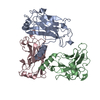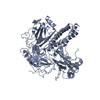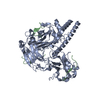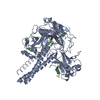[English] 日本語
 Yorodumi
Yorodumi- PDB-1ca9: STRUCTURE OF TNF RECEPTOR ASSOCIATED FACTOR 2 IN COMPLEX WITH A P... -
+ Open data
Open data
- Basic information
Basic information
| Entry | Database: PDB / ID: 1ca9 | ||||||
|---|---|---|---|---|---|---|---|
| Title | STRUCTURE OF TNF RECEPTOR ASSOCIATED FACTOR 2 IN COMPLEX WITH A PEPTIDE FROM TNF-R2 | ||||||
 Components Components |
| ||||||
 Keywords Keywords | TNF SIGNALING /  TRAF / TRAF /  ADAPTER PROTEIN / ADAPTER PROTEIN /  CELL SURVIVAL CELL SURVIVAL | ||||||
| Function / homology |  Function and homology information Function and homology informationglial cell-neuron signaling / regulation of cytokine production involved in immune response / CD40 receptor binding /  tumor necrosis factor receptor superfamily complex / pulmonary valve development / RNA destabilization / tumor necrosis factor receptor superfamily complex / pulmonary valve development / RNA destabilization /  sphingolipid binding / aortic valve development / sphingolipid binding / aortic valve development /  tumor necrosis factor receptor activity / negative regulation of extracellular matrix constituent secretion ...glial cell-neuron signaling / regulation of cytokine production involved in immune response / CD40 receptor binding / tumor necrosis factor receptor activity / negative regulation of extracellular matrix constituent secretion ...glial cell-neuron signaling / regulation of cytokine production involved in immune response / CD40 receptor binding /  tumor necrosis factor receptor superfamily complex / pulmonary valve development / RNA destabilization / tumor necrosis factor receptor superfamily complex / pulmonary valve development / RNA destabilization /  sphingolipid binding / aortic valve development / sphingolipid binding / aortic valve development /  tumor necrosis factor receptor activity / negative regulation of extracellular matrix constituent secretion / positive regulation of apoptotic process involved in morphogenesis / IRE1-TRAF2-ASK1 complex / Defective RIPK1-mediated regulated necrosis / varicosity / regulation of T cell cytokine production / TRAF2-GSTP1 complex / negative regulation of neuroinflammatory response / negative regulation of glial cell apoptotic process / TNFs bind their physiological receptors / negative regulation of cardiac muscle hypertrophy / Regulation by c-FLIP / CASP8 activity is inhibited / Dimerization of procaspase-8 / tumor necrosis factor receptor activity / negative regulation of extracellular matrix constituent secretion / positive regulation of apoptotic process involved in morphogenesis / IRE1-TRAF2-ASK1 complex / Defective RIPK1-mediated regulated necrosis / varicosity / regulation of T cell cytokine production / TRAF2-GSTP1 complex / negative regulation of neuroinflammatory response / negative regulation of glial cell apoptotic process / TNFs bind their physiological receptors / negative regulation of cardiac muscle hypertrophy / Regulation by c-FLIP / CASP8 activity is inhibited / Dimerization of procaspase-8 /  tumor necrosis factor binding / TNF receptor superfamily (TNFSF) members mediating non-canonical NF-kB pathway / interleukin-17-mediated signaling pathway / programmed necrotic cell death / positive regulation of myelination / TNF signaling / Caspase activation via Death Receptors in the presence of ligand / CD40 receptor complex / regulation of neuroinflammatory response / signal transduction involved in regulation of gene expression / activation of NF-kappaB-inducing kinase activity / mRNA stabilization / vesicle membrane / mitogen-activated protein kinase kinase kinase binding / positive regulation of tumor necrosis factor-mediated signaling pathway / tumor necrosis factor binding / TNF receptor superfamily (TNFSF) members mediating non-canonical NF-kB pathway / interleukin-17-mediated signaling pathway / programmed necrotic cell death / positive regulation of myelination / TNF signaling / Caspase activation via Death Receptors in the presence of ligand / CD40 receptor complex / regulation of neuroinflammatory response / signal transduction involved in regulation of gene expression / activation of NF-kappaB-inducing kinase activity / mRNA stabilization / vesicle membrane / mitogen-activated protein kinase kinase kinase binding / positive regulation of tumor necrosis factor-mediated signaling pathway /  thioesterase binding / thioesterase binding /  tumor necrosis factor receptor binding / positive regulation of extrinsic apoptotic signaling pathway / regulation of immunoglobulin production / positive regulation of membrane protein ectodomain proteolysis / TNFR1-induced proapoptotic signaling / tumor necrosis factor receptor binding / positive regulation of extrinsic apoptotic signaling pathway / regulation of immunoglobulin production / positive regulation of membrane protein ectodomain proteolysis / TNFR1-induced proapoptotic signaling /  regulation of myelination / RIPK1-mediated regulated necrosis / TRAF6 mediated IRF7 activation / positive regulation of oligodendrocyte differentiation / regulation of T cell proliferation / non-canonical NF-kappaB signal transduction / protein K63-linked ubiquitination / Interleukin-10 signaling / TRAF6 mediated NF-kB activation / regulation of JNK cascade / intrinsic apoptotic signaling pathway in response to endoplasmic reticulum stress / cellular response to nitric oxide / regulation of protein-containing complex assembly / protein autoubiquitination / specific granule membrane / signaling adaptor activity / extrinsic apoptotic signaling pathway / regulation of myelination / RIPK1-mediated regulated necrosis / TRAF6 mediated IRF7 activation / positive regulation of oligodendrocyte differentiation / regulation of T cell proliferation / non-canonical NF-kappaB signal transduction / protein K63-linked ubiquitination / Interleukin-10 signaling / TRAF6 mediated NF-kB activation / regulation of JNK cascade / intrinsic apoptotic signaling pathway in response to endoplasmic reticulum stress / cellular response to nitric oxide / regulation of protein-containing complex assembly / protein autoubiquitination / specific granule membrane / signaling adaptor activity / extrinsic apoptotic signaling pathway /  ubiquitin ligase complex / positive regulation of JUN kinase activity / tumor necrosis factor-mediated signaling pathway / positive regulation of interleukin-2 production / response to endoplasmic reticulum stress / TNFR1-induced NF-kappa-B signaling pathway / Regulation of NF-kappa B signaling / TNFR2 non-canonical NF-kB pathway / Regulation of TNFR1 signaling / RING-type E3 ubiquitin transferase / protein catabolic process / Regulation of necroptotic cell death / cytoplasmic side of plasma membrane / positive regulation of T cell cytokine production / cellular response to growth factor stimulus / positive regulation of DNA-binding transcription factor activity / ubiquitin-protein transferase activity / intrinsic apoptotic signaling pathway in response to DNA damage / protein-macromolecule adaptor activity / positive regulation of NF-kappaB transcription factor activity / ubiquitin ligase complex / positive regulation of JUN kinase activity / tumor necrosis factor-mediated signaling pathway / positive regulation of interleukin-2 production / response to endoplasmic reticulum stress / TNFR1-induced NF-kappa-B signaling pathway / Regulation of NF-kappa B signaling / TNFR2 non-canonical NF-kB pathway / Regulation of TNFR1 signaling / RING-type E3 ubiquitin transferase / protein catabolic process / Regulation of necroptotic cell death / cytoplasmic side of plasma membrane / positive regulation of T cell cytokine production / cellular response to growth factor stimulus / positive regulation of DNA-binding transcription factor activity / ubiquitin-protein transferase activity / intrinsic apoptotic signaling pathway in response to DNA damage / protein-macromolecule adaptor activity / positive regulation of NF-kappaB transcription factor activity /  cell cortex / regulation of apoptotic process / cell cortex / regulation of apoptotic process /  protein phosphatase binding / protein-containing complex assembly / Interleukin-4 and Interleukin-13 signaling / positive regulation of canonical NF-kappaB signal transduction / cellular response to lipopolysaccharide / molecular adaptor activity / Ub-specific processing proteases / protein phosphatase binding / protein-containing complex assembly / Interleukin-4 and Interleukin-13 signaling / positive regulation of canonical NF-kappaB signal transduction / cellular response to lipopolysaccharide / molecular adaptor activity / Ub-specific processing proteases /  inflammatory response / inflammatory response /  immune response / immune response /  membrane raft / membrane raft /  innate immune response / neuronal cell body / innate immune response / neuronal cell body /  ubiquitin protein ligase binding / Neutrophil degranulation / protein-containing complex binding / ubiquitin protein ligase binding / Neutrophil degranulation / protein-containing complex binding /  protein kinase binding / perinuclear region of cytoplasm protein kinase binding / perinuclear region of cytoplasmSimilarity search - Function | ||||||
| Biological species |   Homo sapiens (human) Homo sapiens (human) | ||||||
| Method |  X-RAY DIFFRACTION / X-RAY DIFFRACTION /  SYNCHROTRON / SYNCHROTRON /  MOLECULAR REPLACEMENT / Resolution: 2.3 Å MOLECULAR REPLACEMENT / Resolution: 2.3 Å | ||||||
 Authors Authors | Park, Y.C. / Burkitt, V. / Villa, A.R. / Tong, L. / Wu, H. | ||||||
 Citation Citation |  Journal: Nature / Year: 1999 Journal: Nature / Year: 1999Title: Structural basis for self-association and receptor recognition of human TRAF2. Authors: Park, Y.C. / Burkitt, V. / Villa, A.R. / Tong, L. / Wu, H. | ||||||
| History |
|
- Structure visualization
Structure visualization
| Structure viewer | Molecule:  Molmil Molmil Jmol/JSmol Jmol/JSmol |
|---|
- Downloads & links
Downloads & links
- Download
Download
| PDBx/mmCIF format |  1ca9.cif.gz 1ca9.cif.gz | 242.3 KB | Display |  PDBx/mmCIF format PDBx/mmCIF format |
|---|---|---|---|---|
| PDB format |  pdb1ca9.ent.gz pdb1ca9.ent.gz | 192.9 KB | Display |  PDB format PDB format |
| PDBx/mmJSON format |  1ca9.json.gz 1ca9.json.gz | Tree view |  PDBx/mmJSON format PDBx/mmJSON format | |
| Others |  Other downloads Other downloads |
-Validation report
| Arichive directory |  https://data.pdbj.org/pub/pdb/validation_reports/ca/1ca9 https://data.pdbj.org/pub/pdb/validation_reports/ca/1ca9 ftp://data.pdbj.org/pub/pdb/validation_reports/ca/1ca9 ftp://data.pdbj.org/pub/pdb/validation_reports/ca/1ca9 | HTTPS FTP |
|---|
-Related structure data
| Related structure data |  1ca4SC S: Starting model for refinement C: citing same article ( |
|---|---|
| Similar structure data |
- Links
Links
- Assembly
Assembly
| Deposited unit | 
| ||||||||||
|---|---|---|---|---|---|---|---|---|---|---|---|
| 1 | 
| ||||||||||
| 2 | 
| ||||||||||
| 3 | 
| ||||||||||
| Unit cell |
| ||||||||||
| Noncrystallographic symmetry (NCS) | NCS oper: (Code: given / Matrix: (1), |
- Components
Components
| #1: Protein | Mass: 21706.980 Da / Num. of mol.: 6 / Fragment: TRAF DOMAIN Source method: isolated from a genetically manipulated source Source: (gene. exp.)   Homo sapiens (human) / Plasmid: PET24D / Species (production host): Escherichia coli / Production host: Homo sapiens (human) / Plasmid: PET24D / Species (production host): Escherichia coli / Production host:   Escherichia coli BL21 (bacteria) / Strain (production host): BL21 / References: UniProt: Q12933 Escherichia coli BL21 (bacteria) / Strain (production host): BL21 / References: UniProt: Q12933#2: Protein/peptide | Mass: 1124.243 Da / Num. of mol.: 2 / Fragment: TRAF-BINDING SITE / Source method: obtained synthetically Details: SEQUENCE FROM HUMAN TNF-R2, SWISS PROT ACCESSION P20333 References: UniProt: P20333 #3: Water | ChemComp-HOH / |  Water Water |
|---|
-Experimental details
-Experiment
| Experiment | Method:  X-RAY DIFFRACTION / Number of used crystals: 1 X-RAY DIFFRACTION / Number of used crystals: 1 |
|---|
- Sample preparation
Sample preparation
| Crystal | Density Matthews: 2.52 Å3/Da / Density % sol: 51.2 % | |||||||||||||||
|---|---|---|---|---|---|---|---|---|---|---|---|---|---|---|---|---|
Crystal grow | pH: 5.6 / Details: pH 5.6 | |||||||||||||||
| Crystal grow | *PLUS Temperature: 20 ℃ / pH: 6 / Method: unknown | |||||||||||||||
| Components of the solutions | *PLUS
|
-Data collection
| Diffraction | Mean temperature: 100 K |
|---|---|
| Diffraction source | Source:  SYNCHROTRON / Site: SYNCHROTRON / Site:  NSLS NSLS  / Beamline: X4A / Wavelength: 0.987 / Beamline: X4A / Wavelength: 0.987 |
| Detector | Type: RIGAKU RAXIS IV / Detector: IMAGE PLATE |
| Radiation | Protocol: SINGLE WAVELENGTH / Monochromatic (M) / Laue (L): M / Scattering type: x-ray |
| Radiation wavelength | Wavelength : 0.987 Å / Relative weight: 1 : 0.987 Å / Relative weight: 1 |
| Reflection | Resolution: 2.3→20 Å / Num. all: 59650 / Num. obs: 59650 / % possible obs: 99 % / Observed criterion σ(I): 0 / Rmerge(I) obs: 0.048 |
| Reflection | *PLUS |
| Reflection shell | *PLUS % possible obs: 97.9 % / Rmerge(I) obs: 0.279 |
- Processing
Processing
| Software |
| ||||||||||||||||||||||||||||||||||||||||||||||||||||||||||||
|---|---|---|---|---|---|---|---|---|---|---|---|---|---|---|---|---|---|---|---|---|---|---|---|---|---|---|---|---|---|---|---|---|---|---|---|---|---|---|---|---|---|---|---|---|---|---|---|---|---|---|---|---|---|---|---|---|---|---|---|---|---|
| Refinement | Method to determine structure : :  MOLECULAR REPLACEMENT MOLECULAR REPLACEMENTStarting model: 1CA4 Resolution: 2.3→20 Å / Cross valid method: THROUGHOUT / σ(F): 2
| ||||||||||||||||||||||||||||||||||||||||||||||||||||||||||||
| Displacement parameters | Biso mean: 47.1 Å2 | ||||||||||||||||||||||||||||||||||||||||||||||||||||||||||||
| Refinement step | Cycle: LAST / Resolution: 2.3→20 Å
| ||||||||||||||||||||||||||||||||||||||||||||||||||||||||||||
| Refine LS restraints |
| ||||||||||||||||||||||||||||||||||||||||||||||||||||||||||||
| Refine LS restraints NCS | NCS model details: RESTRAINTS | ||||||||||||||||||||||||||||||||||||||||||||||||||||||||||||
| Software | *PLUS Name: CNS / Version: 0.3 / Classification: refinement | ||||||||||||||||||||||||||||||||||||||||||||||||||||||||||||
| Refinement | *PLUS Rfactor obs: 0.234 | ||||||||||||||||||||||||||||||||||||||||||||||||||||||||||||
| Solvent computation | *PLUS | ||||||||||||||||||||||||||||||||||||||||||||||||||||||||||||
| Displacement parameters | *PLUS | ||||||||||||||||||||||||||||||||||||||||||||||||||||||||||||
| Refine LS restraints | *PLUS
|
 Movie
Movie Controller
Controller










 PDBj
PDBj














